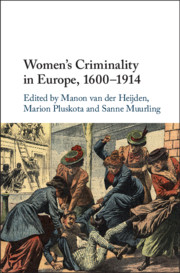Book contents
- Women’s Criminality in Europe, 1600–1914
- Women’s Criminality in Europe, 1600–1914
- Copyright page
- Dedication
- Contents
- Figures and Tables
- Contributors
- 1 Introduction
- 2 Explaining Crime and Gender in Europe between 1600 and 1900
- Part I Violence, Space and Gender
- Part II Prosecution and Punishment
- 5 Gender and the Prosecution of Adultery in Geneva, 1550–1700
- 6 ‘Find the Lady’
- 7 Gender and Release from Imprisonment
- 8 Female and Male Prisoners in Queensland 1880–1899
- Part III Representation of Crime
- Bibliography
- Index
7 - Gender and Release from Imprisonment
Convict Licensing Systems in Mid- to Late Nineteenth-Century England
from Part II - Prosecution and Punishment
Published online by Cambridge University Press: 10 January 2020
- Women’s Criminality in Europe, 1600–1914
- Women’s Criminality in Europe, 1600–1914
- Copyright page
- Dedication
- Contents
- Figures and Tables
- Contributors
- 1 Introduction
- 2 Explaining Crime and Gender in Europe between 1600 and 1900
- Part I Violence, Space and Gender
- Part II Prosecution and Punishment
- 5 Gender and the Prosecution of Adultery in Geneva, 1550–1700
- 6 ‘Find the Lady’
- 7 Gender and Release from Imprisonment
- 8 Female and Male Prisoners in Queensland 1880–1899
- Part III Representation of Crime
- Bibliography
- Index
Summary
This chapter draws on research into the lives and prison experiences of around 650 male and female convicts who were released on licence (an early form of parole) from sentences of long-term imprisonment in England in the mid- to late nineteenth century. While both men and women were overwhelmingly committed to the convict system for larceny, their treatment differed significantly. The vast majority of convicts were released early on licence from their prison terms, even those committing very serious offences. However, female offenders were released slightly earlier and under different conditions than men. Having offended against their gender as well as society, more moral rehabilitation was deemed necessary for deviant women than for men, leading to requirements such as entering refuges or shelters. Female convicts’ internment in these institutions after being granted a licence reveals the impact of gender expectations on female prisoners in England.
Keywords
- Type
- Chapter
- Information
- Women's Criminality in Europe, 1600–1914 , pp. 134 - 147Publisher: Cambridge University PressPrint publication year: 2020
- 1
- Cited by

